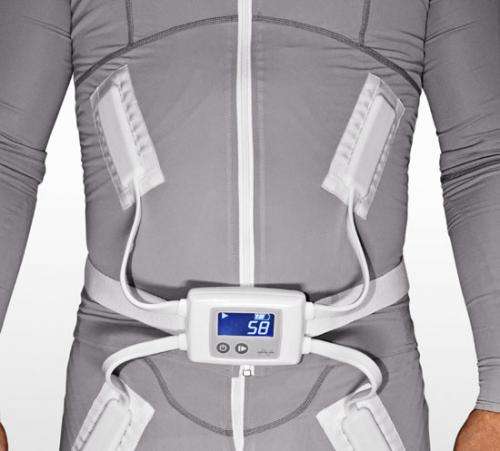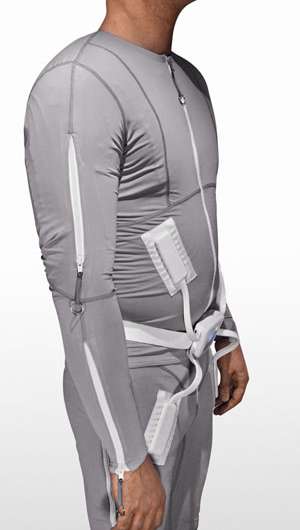Suited for treatment of brain damage

For those with brain damage or neurological disorders - such as MS or Parkinson's - treatment could be as close as the wardrobe.
Improved range of motion and reduced pain for people with brain injuries and neurological disorders may now be available with a specially-designed elastic body suit fitted with electrodes, which was designed at Stockholm's KTH Royal Institute of Technology in collaboration with health care and business partners.
The Mollii garment provides an alternative to painful treatments and surgery, by treating the body with electrical stimulation to ease tension and spasms. The result is reduced pain perception and increased mobility.
The idea originated with a Swedish chiropractor, Fredrik Lundqvist, who worked with rehabilitation of brain-damaged patients. Lundqvist struck upon the idea of sewing electrical stimuli – similar to TENS (transcutaneous electrical nerve stimulation) electrodes – into garments that the patient can wear.
He turned to KTH researchers Johan Gawell and Jonas Wistrand at the Department of Machine Design at KTH. "They produced a prototype of the product, and today they are working full time on the development of Mollii," Lundqvist says.
Designed with ordinary swimsuit material, the body suit has conductive elastic sewn into it, with electrodes located at the major muscles.
Battery-powered light current is conducted via silver wires to 58 electrodes attached to the inside of the garment, which in turn stimulate as many as distinct 42 muscles, according to the patient's needs.
Batteries are placed in a small control box fitted at the waistband.

"The idea is that the clothes should be used for a few hours, three times a week, and the effect is expected to last for up to two days," Lundqvist says.
Users are advised engage in movement through training and stretching during the treatment.
"To enhance the quality of life the patient may choose to use Mollii before it's time to go to work, school or to a social event. That enables the body to function as well as possible when it is really needed," he says.
The garment has been shown to be highly effective in patient examinations performed in collaboration with a PhD student Stockholm's Karolinska Institute, Lundvist says. "One-hundred percent of the participants in the survey say they have experienced improvements in existing function or quality of life," he says.
Stroke patients with paralysis on one side have been found to gain increased mobility in spastic limbs, in that they had improved gait and their arms and hands worked better after treatment.
"As a bonus, the patients often sleep better, and their pharyngeal motor skills and speech improved after using Mollii," Lundqvist says.
"It can also help children with physical disabilities or motor difficulties in the feet, such as constantly walking on toes or with their feet at inward angles," Lundqvist says.
Treating patients with movement difficulties and pain due to neurological damage can often require surgery, injections of botolinumtoxin (neurotoxin) or strong medications.
"These treatments mean high costs and side effects, while our clothes are simple and safe to use," Lundqvist says. "You can reduce the number of hospital visits because the therapy can be performed at home. And when the mobility increases, there is less need for walkers or wheelchairs."
Mollii is an approved CE marked medical device, but independent clinical tests have yet been performed. But the company behind the treatment, Inerventions, has launched a scientific study of the clinical effectiveness of the garment, in partnership with Sweden's Rehab Medical clinics. Lundqvist says the results should come next year.
Today, Mollii is available through the Swedish health care system as a personal tool prescribed by physical or occupational therapists. And the garment can also be purchased directly from Inerventions.
The price is about EUR 5,600 for two years guaranteed spasticity treatment. If the suit during that time becomes too small, the patient can switch to a new, tested garment at no additional cost.
In Denmark, the garment is already subsidized with municipal funds for treatment of nerve damage, based on recommendations from a physiotherapist.
Inerventions' goal is to establish Mollii in Europe, the U.S. and Japan. The garment can in the future be used to help patients with chronic pain and people with Restless Legs Syndrome (RLS).
















